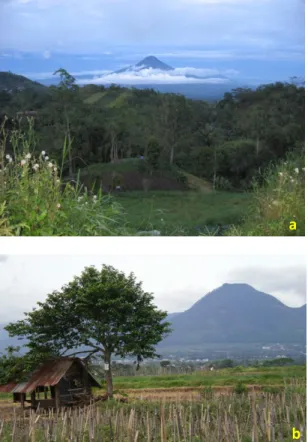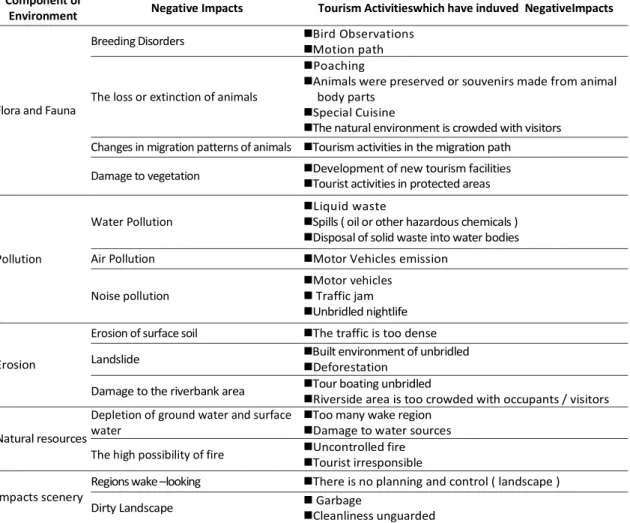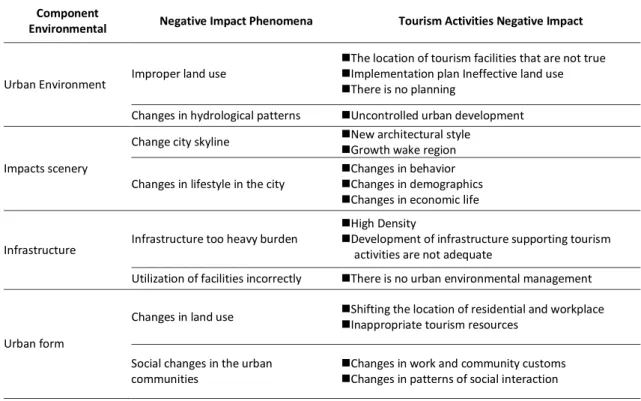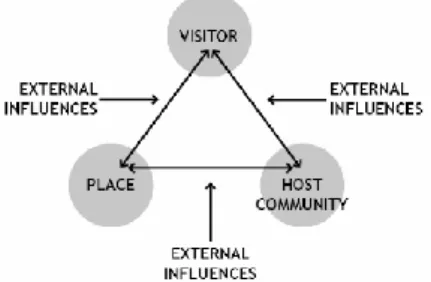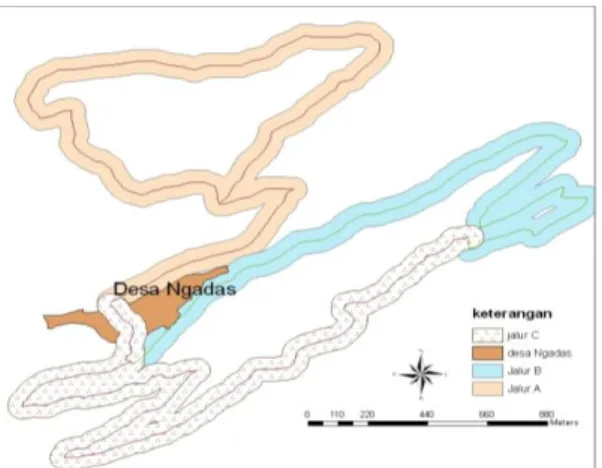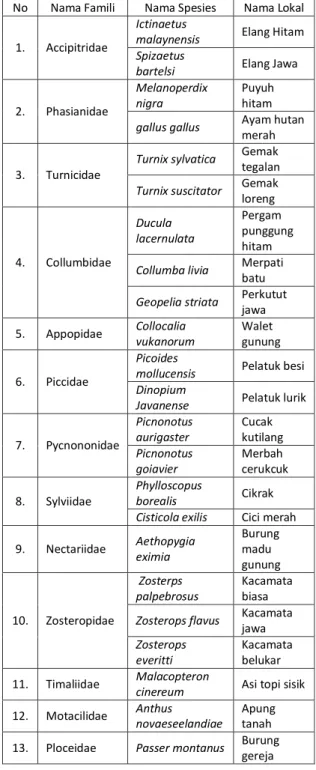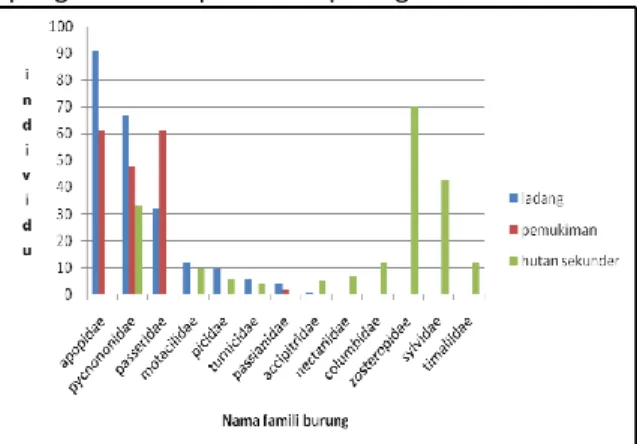The ecotourism is global issue that has been most talked about recently in Indonesia, it is one of the activities special tourist interest, which low impact on natural tourism. The presence of ecotourism in an era of sustainable and tourism development mission should be the least possible negative impacts, both on environmental resources and on socio-cultural local values. The carrying capacity of tourism has been influenced by several factors of tourist motivation and environmental characteristics of the ecotourism locations. The socio-cultural values also play an important role in maintaining long-term sustainability.
The natural environment is crowded with visitors Changes in animal migration patterns Tourist activities on the migration path. Research results from Kumurur (2002) show that the existence of development activities in Tondano Lake has resulted in a deterioration of the lake's water quality. The activities of tourism have led to socio-economic impacts on the local communities of Jayapura district.
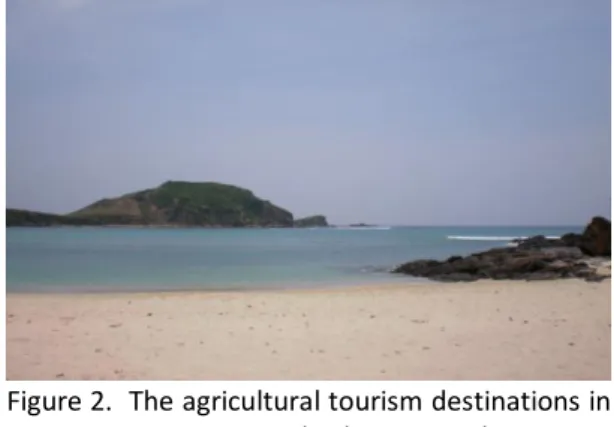
Sustainable Ecotourism
The use of water hyacinth materials as souvenirs has increased the population of this aquatic plant. However, there are also negative impacts due to tourism activities, which are the amount of solid waste (garbage) from tourist attractions, the low level of security around tourist sites, the decline of cultural and ethical values in local communities. Research findings (Siagian, 2006) show that development activities in Lake Toba areas have caused a number of negative impacts on the natural environment. The physical characteristics of Lake Toba have changed, with an increase in the number of goldfish deaths in “Karamba Jala Apung” (KJA) in the lake water. In terms of socio-economic aspects, according to Noferi (2007) in his research, ecotourism activities at Lake Maninjau also show impacts on local communities' livelihoods, income, employment and public health.
Limiting the number of tourists visiting tourist destinations or tourist attractions at a given time (carrying capacity) is very important in the development of sustainable tourism.
General Discussion
The development of tourism in Indonesia should not cause any local community to lose its traditional "skills" that it had previously possessed. If this were the case, then in addition to the loss of local knowledge, local communities could also be threatened with the loss of jobs or other sources of income. Therefore, the development of tourism must adapt to the characteristics of employment that already exist (Antariksa, 2011).
When in a tourist destination the main livelihood of the local population is agriculture, then agritourism should be developed. All stakeholders (individuals, communities, ecotourists, tour operators and relevant governments and non-governmental organisations) should be involved in the planning, development, implementation and monitoring phase. This stakeholder involvement should be in line with cultures and local traditions, resulting in a fair and sustainable income for local communities, stakeholders and local tour operators.
In order to mitigate negative impacts from any tourism activities, efforts should be made to anticipate negative impacts, among other things, by making relevant cooperation between sectors involved in ecotourism activities for both governments, private sectors, local communities, researchers and tourists; enabling more wisdom communities; brought together to improve environmental comfort by planting trees; provide incentives for additional workers;. A successful effort to minimize the impacts of ecotourism can be achieved if there is good coordination among all concerned parties to realize a cross-sectoral integration to avoid conflicts of interest between sectors. Thus, the conservation of the natural environment is preserved and maintained for the sustainability of ecotourism in Indonesia.
Pengembangan ekowisata Indonesia dalam kaitannya dengan pengendalian kerusakan keanekaragaman hayati di taman nasional dan taman wisata alam. Dampak Lingkungan Ekowisata di Indonesia (Butarbutar, dkk). http://www.ekowisata.info/pengembangan _ekowisata.html).
KAJIAN JENIS - JENIS BURUNG DI DESA NGADAS SEBAGAI DASAR PERENCANAAN JALUR PENGAMATAN BURUNG (Birdwatching)
Famili Burung yang Ada di Desa Ngadas Desa Ngadas memiliki keanekaragaman
Jenis burung ini ditemukan di 3 karakter tanah di Desa Ngadas yaitu pemukiman, ladang dan hutan sekunder. Keberadaan jenis vegetasi tersebut bersama-sama dengan faktor-faktor lain baik biotik maupun abiotik pada setiap karakter lahan di Desa Ngadas akan memberikan dukungan fungsional terhadap keberadaan burung berupa ketersediaan makanan, air, perlindungan dari panas dan predator serta tempat. untuk bersarang, beristirahat dan menjaga anak-anaknya. Berdasarkan pengamatan yang dilakukan diketahui beberapa famili yang berada di wilayah Desa Ngadas antara lain Turnicidae, Motacilidae, Apopidae, Piccidae, Passeridae, Pycnononidae, Nectaridae, Zosteropidae, Accipitridae, Sylviidae, Phasianidae dan Columbidae.
Turnicidae merupakan suku burung dengan ukuran kecil, ekor pendek dan tubuh umumnya kekar. Sebagian besar burung kutilang yang termasuk dalam filum ini sekilas menyerupai brajangan, namun memiliki ciri-ciri anggota badan yang lebih panjang dan paruh yang lebih ramping [6]. Mempunyai ciri-ciri sayap panjang dan lancip, mengarah kebelakang ketika terbang, ekor pendek atau persegi atau panjang, kaki sangat kecil, jarang bertengger di pohon, biasanya bertumpu pada pohon, batu atau tembok dengan bantuan kukunya yang tajam [6].
Sebaran Spasial dan Temporal Burung Desa Ngadas
- Distribusi Spasial Burung di Desa Ngadas Berdasarkan penelitian yang telah
- Distribusi Temporal Burung di Desa Ngadas Dari 13 famili burung yang ditemukan,
- Perencanaan Jalur Pengamatan Burung dan Wilayah Konservasi
Dengan mengetahui pola sebaran temporal jenis burung di Desa Ngadas, maka dapat diperoleh gambaran mengenai kegiatan birding yang akan dilakukan. Informasi terkait sebaran temporal jenis burung di Desa Ngadas dapat dijadikan pedoman kapan waktu pengamatan yang paling tepat dan tepat. Berdasarkan pola sebaran burung di Desa Ngadas secara temporal terlihat bahwa burung lebih banyak beraktivitas pada pagi hari, oleh karena itu disarankan kegiatan pengamatan burung dilakukan pada pagi hari, dengan waktu pengamatan antar jam sebagai waktu pengamatan. dilakukan. oleh para peneliti.
Jalur konservasi yang terletak di hutan sekunder dalam kawasan Taman Nasional Bromo Tengger Semeru dipilih pada lokasi yang tidak terlalu jauh dari kawasan desa Ngadas dengan pertimbangan untuk menjaga jumlah dan jenis burung yang ada di kawasan desa Ngadas dengan menyediakan tempat berkembang biak Selain itu, pertimbangan lain yang diambil adalah bahwa di kawasan tersebut terdapat burung berstatus NT (Near Threatened) atau jenis burung yang masuk dalam kategori terancam hampir punah yaitu Zosterops flavus atau dikenal juga dengan sebutan burung berkacamata jawa. Serta burung yang berstatus terancam punah (EN) yaitu elang jawa atau Spizaetus bartelsi.
Dengan adanya jalur konservasi ini, maka pengamatan burung di jalur ini harus dilakukan dengan peraturan yang lebih ketat. Spesies tersebut antara lain Ictinaetus malaynensis dan Spizaetus bartelsi yang merupakan anggota famili Accipitridae, Melanoperdix nigra dan gallus gallus dari famili Phasianidae, Turnix sylvatica dan Turnix suscitator yang merupakan anggota famili Turnicidae. Aethopygia eximia adalah anggota Nectaridae, Zosterps palpebrosus, Zosterops flavus dan Zosterops everitti dari keluarga Zosteropidae.
Passer montanus dari famili Plocidae, malacopteron cinereum dari famili Timaliidae dan Anthus novaeseelandiae dari famili Motacilidae. Saran yang dapat disampaikan berdasarkan analisis yang dilakukan adalah penelitian ini dapat dilanjutkan dengan upaya pelaksanaan Ekowisata Pengamatan Burung di Desa Ngadas agar keberadaan burung di wilayah desa Ngadas menjadi daya tarik tersendiri bagi kegiatan wisata di Ngadas desa, selain memberikan pendidikan dan pelatihan tentang pengelolaan kegiatan wisata birdwatching bagi masyarakat setempat, akan memberikan nilai tambah bagi pelaksanaan kegiatan wisata birdwatching di desa Ngadas ini.
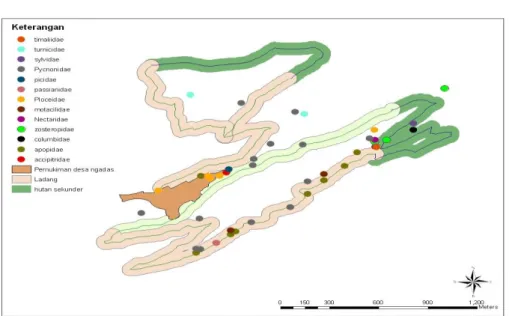
REVIEW: TAXONOMIC CONTRIBUTION FOR ECOTOURISM DEVELOPMENT IN INDONESIA
It is estimated that 40 percent of the global economy is based on biological products and processes. Percentage of biodiversity can be affected by several factors; one of them is the rapid development of the tourism industry. Taxonomy is one of the sciences that studies the observation, nomenclature and classification of species or organisms in the world.
One of the examples from the successful development of ecotourism was carried out by a group of anglers in Serangan Village, Bali through seahorse breeding and development of floating zone of ecotourism. One of them is bird watching, while the observation of the bird race is called Bird Watching Race. Bird watching is one of the efforts to increase students' awareness of the environment, especially birds, and promote ecotourism.
Based on the statement of Allen and Erdmann [9], the main objective of the species survey was to provide a comprehensive account of the species found at the site. In addition to providing a comprehensive species account, these surveys may also identify new species found at the site. Mangroves are one of the important coastal and marine ecosystems, along with coral reefs and sea grass.
For example, the identification of six new species of squaloid shark in the genus Etmopterus [10]. Vocalization was performed by determining the vocal character of a species by comparing vocal data with vocal data of another species [6]; [31]. Description of six new species of lantern sharks of the genus Etmopterus (Squaloidea: Etmopteridae) from the Australasian region.
A new record of the genus Sinella in Indonesia with a new species of the subgenus Coecobrya (Collembola: Entomobryidae).
ECO-HOMESTAY: DEVELOPMENT CONCEPT ON RURAL TOURISM-BASED CONSERVATION MODEL
Study Case of Sidomulyo Village, Silo District, Jember Regency)
An eco-homestay is an accommodation facility in the area of a local eco-tourism destination, which is natural, clean, healthy, safe, tidy and environmentally friendly. The development of eco-homes tries to diversify the income of local communities by introducing limitations to the concept of ecotourism development [7]. In addition, the eco-homestay, if properly managed, will create a positive added value in the marketing of tourism in the area.
The socialization of eco-homestays to the community started with advice being given on the importance of a clean and beautiful living environment [7,8]. Therefore, intensive training and coaching for the community on the benefits of eco-homestay management should be implemented periodically. Located near the Meru Betiri National Park (MBNP), establishing eco-homestay programs in the area of such a village becomes strategically important.
The initial phase of eco-house development can be initiated by community members as a voluntary activity. Any income from the eco-home should be set aside for cash contributions to local community groups. The concept to accommodate and use the local architectural style in the eco-house is one of the main spirits of the implementation of ecotourism in the world [6].
The development of eco-residences is useful for the development of local income while maintaining the concept of ecotourism development and environmental preservation. If the eco-homestead was managed by professionals, it would have a positive impact on the implementation of conservation in a tourism-based area.
![Figure 1. Accesibility to Sidomulyo Village, Silo District to Meru Betiri National Park [10]](https://thumb-ap.123doks.com/thumbv2/123dok/10279570.0/32.893.108.390.336.564/figure-accesibility-sidomulyo-village-silo-district-betiri-national.webp)
